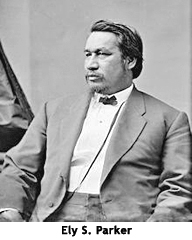|
Ely S. Parker. . .
True native American penned final copy
of surrender document at Appomattox
The occasion that officially ended the Civil War took place on Palm Sunday, April 9, 1865. The terms of surrender were recorded by Union Lt. Col. Ely S. Parker, a Seneca Indian.
 Confederate Gen. Robert E. Lee met Parker after the surrender was finalized and remarked as he viewed the Colonel’s dark features: “I’m glad to see one real American here.” Confederate Gen. Robert E. Lee met Parker after the surrender was finalized and remarked as he viewed the Colonel’s dark features: “I’m glad to see one real American here.”
Parker immediately replied, “We are all Americans.”
Union Gen. U.S. Grant had committed terms of the surrender into a manifold order book whose leaves made it possible to make three impressions. He wrote quickly, pausing only as he was writing a final sentence. He then gave the document to Parker, asking him to review it and suggest any changes. Parker made some minor suggestions, made the appropriate changes and handed the book to Lee. Grant asked Parker to read a copy aloud. Lee asked that his men be permitted to keep their horses, which was given verbal approval, and the surrender was finalized. Parker then made a final copy in ink.
Parker, the “real American,” was proud of his heritage and overcame bigotry with courage, belief in himself and some luck. Known as “Hasanoanda – the reader,” he was born in 1828 on the Towanda Indian Reservation in western New York. Mocked as a young boy while working at an army post for speaking pidgin English, he ultimately became renowned for his eloquence in the language, with penmanship so impressive he won the privilege of drafting the surrender documents ending the Civil War. Ambitious to advance in the white man’s world, he changed his name to Ely Samuel Parker, with Ely pronounced e-Lee as in Robert E. Lee.
Unfortunately, Parker faced the kind of prejudice that unified Southerners – and that would persist despite the Northern victory. He studied civil engineering at Rensselaer Polytechnic in Troy, N.Y., and apprenticed to be a lawyer for three years, only to discover that as a Seneca Indian – one of six nations making up the Iroquois confederation – he was not an American citizen and thus ineligible for the bar. Native Americans would secure those basic rights only in 1924 with the Indian Citizenship Act.
In 1852, Parker became a sachem, a subordinate chief renamed Donehogawa – keeper of the Western Door of the Long House of the Iroquois. After working on the Erie Canal, Parker ended up at the Mississippi River town of Galena, Ill. There, he befriended a former West Point Army captain working as a store clerk. By 1864, Grant was Abraham Lincoln’s best general. Parker served as U.S. Grant’s military secretary as they fought their way toward Appomattox, eventually becoming the Union’s only Native American Brigadier General.
In the 1860s, when Parker patriotically tried raising a regiment of Iroquois to fight for the North, New York state officials sneered, “The Civil War is a white man’s war … we will settle our own troubles without any Indian aid.”
In 1869, now-President Grant made Parker the first Native American Commissioner of Indian Affairs. Parker’s fair, honest approach toward the Indian tribes alienated his Washington rivals. They blasted Grant for appointing a man “who is but a remove from barbarism.” Undeterred, Parker tried balancing his loyalty to his tribe with his loyalty to his country.
Parker married Minnie Orton Sackett (1849-1932) in 1867. They had one daughter, Maud Theresa (1878-1956).
Living his last years in poverty, Parker died in Fairfield, Conn., on Aug. 31, 1895, where he was buried. The Seneca did not feel Algonquin territory was appropriate for a final resting place and requested that his widow relocate the grave. On Jan. 20, 1897, his body was exhumed and moved to Forest Lawn Cemetery in Buffalo, N.Y. He was reinterred next to his ancestor Red Jacket, a famous Seneca orator, and other notables of western New York.
|

